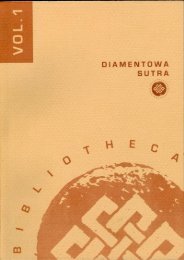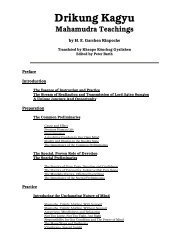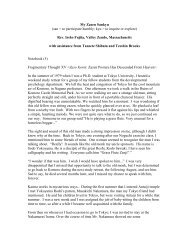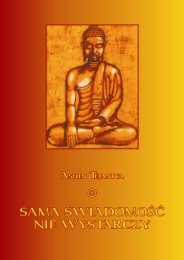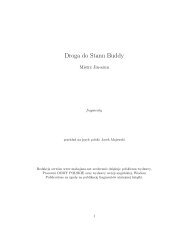3 - Computing in the Humanities and Social Sciences
3 - Computing in the Humanities and Social Sciences
3 - Computing in the Humanities and Social Sciences
Create successful ePaper yourself
Turn your PDF publications into a flip-book with our unique Google optimized e-Paper software.
pronunciation, <strong>in</strong>tonation, <strong>in</strong>tensity of voice, rhythm <strong>and</strong> melodic structure of <strong>the</strong><br />
utterance, but also breath<strong>in</strong>g <strong>and</strong> bodily posture of <strong>the</strong> performer. These rules are much<br />
stricter <strong>and</strong> more detailed than those of ord<strong>in</strong>ary language. Frits Staal proposes to take<br />
<strong>in</strong>to account “<strong>the</strong> importance of musical categories for expla<strong>in</strong><strong>in</strong>g some of <strong>the</strong><br />
characteristics that dist<strong>in</strong>guish mantras from language,” s<strong>in</strong>ce, accord<strong>in</strong>g to him,<br />
“mantras cannot be understood unless <strong>the</strong>ir musical character is taken <strong>in</strong>to account”<br />
(Staal 1989: 65). This is obviously true <strong>in</strong> <strong>the</strong> case of Japanese Buddhist music known as<br />
Shømyø. The term shømyø, a translation of <strong>the</strong> Sanskrit Ωabda-vidyå, “body of knowledge<br />
concern<strong>in</strong>g language,” orig<strong>in</strong>ally <strong>in</strong>dicated grammar <strong>in</strong> general, <strong>and</strong> <strong>the</strong> rules for <strong>the</strong><br />
correct pronunciation of mantras <strong>in</strong> particular. However, <strong>in</strong> Japan it developed <strong>in</strong>to a<br />
full-fledged musical genre with its own <strong>the</strong>ory, repertoire, <strong>and</strong> performance techniques.<br />
(On Shømyø, see Harich-Schneider 1973; Kushida 1964: 409-480). The approach<br />
suggested by Staal is very useful to underst<strong>and</strong> <strong>the</strong> function<strong>in</strong>g of sh<strong>in</strong>gon <strong>in</strong> complexs<br />
rituals <strong>in</strong>tegrat<strong>in</strong>g liturgical, musical, l<strong>in</strong>guistic, <strong>and</strong> artistic-visual elements. However,<br />
it should be emphasized that music expla<strong>in</strong>s only some aspects of mantras.<br />
Syntax<br />
It is not clear whe<strong>the</strong>r mantras follow syntactical rules. Also <strong>in</strong> this regard,<br />
<strong>in</strong>terpretations vary widely. On one side, Frits Staal denies such a possibility, while on<br />
<strong>the</strong> opposite side Donald Lopez <strong>and</strong> Stanley Tambiah are ready to admit it. Buddhist<br />
mantras <strong>and</strong> dhåra√∆ constitute a fixed repertoire of expressions that has not been<br />
changed for centuries. (In <strong>the</strong> past, new rituals <strong>and</strong> new formulae kept proliferat<strong>in</strong>g: see<br />
Hayami 1975, 1987; many premodern rituals, however, are now obsolete <strong>and</strong> are<br />
usually not performed.) L<strong>in</strong>guistic categories such as competence <strong>and</strong> performance lose,<br />
<strong>in</strong> this context, <strong>the</strong>ir relevance: <strong>in</strong> <strong>the</strong> case of mantras competence consists <strong>in</strong> <strong>the</strong><br />
knowledge of <strong>the</strong> status of mantras <strong>and</strong> <strong>the</strong> rules for <strong>the</strong>ir correct performance, whereas<br />
performance is <strong>in</strong> turn simply <strong>the</strong> capacity to perform already exist<strong>in</strong>g formulae<br />
correctly <strong>in</strong> codified contexts. There is usually no marg<strong>in</strong> for l<strong>in</strong>guistic creativity <strong>and</strong><br />
perform<strong>in</strong>g orig<strong>in</strong>ality <strong>in</strong> mantra rituals (even though, however, <strong>the</strong> voice of <strong>the</strong><br />
performer can be a factor of aes<strong>the</strong>tic enjoyment). Perhaps a taxonomical, distributive<br />
<strong>and</strong> componential study of mantric formulas could contribute to determ<strong>in</strong>e whe<strong>the</strong>r<br />
structural <strong>and</strong> distributive regularities also correspond to functional <strong>and</strong> semantic ones.<br />
18



![Shushogi, Dogen Zenji [PDF] - Mahajana.net](https://img.yumpu.com/50921105/1/190x219/shushogi-dogen-zenji-pdf-mahajananet.jpg?quality=85)


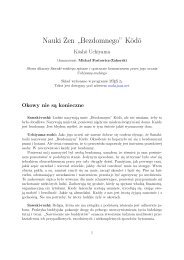

![wywiadu z Murakami Kosho Roshim [PDF] - Buddyzm w Polsce i na ...](https://img.yumpu.com/45809746/1/184x260/wywiadu-z-murakami-kosho-roshim-pdf-buddyzm-w-polsce-i-na-.jpg?quality=85)
